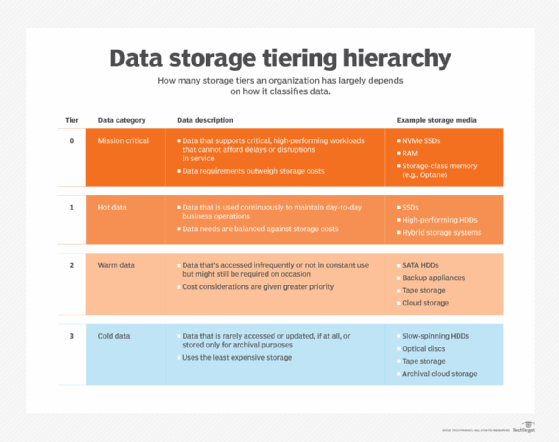Tier 0
What is Tier 0?
Tier 0 is a level of data storage that is faster, and perhaps more expensive, than any other level in the storage hierarchy.
While central processing unit speeds and hard disk drive capacities have been increasing exponentially, HDD input/output operations per second have only improved slightly, putting constraints on application performance.
One way IT administrators have compensated is to tier application data storage and use faster, more expensive HDDs for some items and slower, less expensive HDDs for others. This is known as hierarchical storage management (HSM). The goal of HSM is to increase service levels to critical applications and data sets and reduce the overall cost of data storage.
Addition of Tier 0 to the storage hierarchy
In general, the lower the number of the tier in a tiered storage hierarchy, the more expensive the storage media and the less time it takes to retrieve data on that tier. An enterprise that requires selected applications to be accessed quickly may choose to use expensive solid-state storage in its fastest tier, which some data storage professionals call Tier 0.
The addition of Tier 0 to the data storage hierarchy represents a change from moving less active data to slower, less expensive storage to a focus on moving more active data to faster, more expensive storage.
Here is an example of what a storage hierarchy that incorporates Tier 0 might look like.

History of storage tiers
Before the common use of solid-state drives (SSDs), Tier 0 used a RAM disk or assigned a block of server RAM to function as a virtual disk drive. But using system RAM for this task takes away from the RAM available for computation.
While the first SSDs were more expensive than today's products, the cost per gigabyte was still lower than using system RAM. They also allowed for greater amounts of storage for higher-speed access than the HDDs used in Tier 1. RAM disks also require constant power, while SSDs are made of non-volatile flash memory.
One of the early products on the market was ioDrive, a separate card that plugged into a server, from Fusion-io, later acquired by the now Western Digital-owned SanDisk. It provided flash memory that appeared as an SSD to the storage system. Automated storage tiering (AST) software is now commonly included in hybrid storage arrays that have SSDs and HDDs.
AST software ensures the most frequently accessed data, known as hot data, is moved to the speedy Tier 0. In large enterprise storage systems, entire all-flash arrays can be assigned as Tier 0 storage, with hybrid arrays as Tier 1, HDD arrays as Tier 2 and tape or slower, inexpensive HDD arrays as Tier 3.
Consider cost and performance
While any storage system can benefit from the speed boost of Tier 0, it finds the greatest need in anything that relies on high-performance computing (HPC). Typical HPC applications that use high-transaction databases include medical research, security analysis, financial services and big data analytics.
If performance was the only factor to consider, organizations would have nothing but all-flash arrays in their data storage structures. But cost is also an issue, and that is where HSM becomes a vital player.
By establishing a tiered hierarchy of what storage is needed and how often, admins can implement the least-expensive storage product for each tier. AST software further lowers the cost because it enables an organization to determine just how much frequently accessed data needs to be called hot and how much Tier 0 storage it needs.
Editor's note: This definition was revised in 2023 by TechTarget editors to improve the reader experience.








